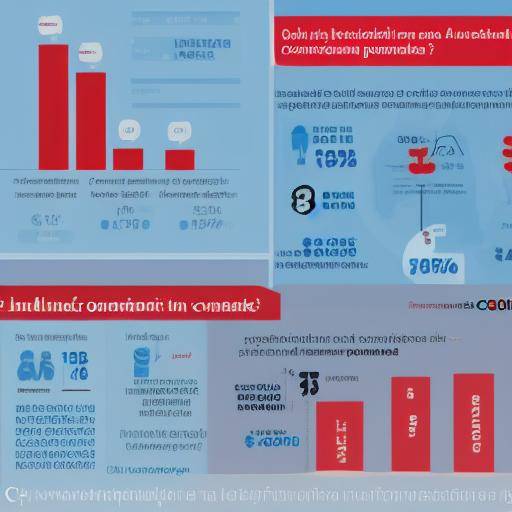
Marketing and advertising have a significant impact on consumer purchasing decisions. As the digital world continues to evolve, the influence of these strategies on consumer behavior becomes even more relevant. In this article, we will explore in detail the influence of marketing and advertising in purchasing decisions, analyzing your control over trends and identifying best practices to maximize their impact.
Introduction
The buying process of a consumer is strongly influenced by marketing and advertising. From the initial exposure to a product or service, to the final purchase decision, these strategies play a crucial role. In this sense, it is crucial to understand how marketing and advertising shape our purchasing decisions and how brands can control this influence to maximize their benefits.
History and Background
Marketing and advertising have evolved significantly over time. From the first printed ads to today's highly segmented digital campaigns, these strategies have experienced a fascinating journey. In the 20th century, technological advance led to a radical change in the way brands communicated with their audiences. Television, radio and, more recently, the Internet have played key roles in the proliferation of advertising messages.
A crucial milestone in marketing history was the application of market research techniques, which enabled brands to better understand the needs and desires of consumers. This marked a paradigm shift in the way marketing and advertising strategies were conceived. With a deeper understanding of consumer motivations, brands were able to optimize their messages and strategies to influence purchasing decisions.
With the arrival of the Internet and social networks, marketing and advertising acquired a completely new dimension. Digital platforms allowed brands to reach highly specific audiences, taking advantage of the power of content marketing and interactivity. This change greatly democratized advertising, allowing businesses of all sizes to reach their audiences more effectively.
Analysis in Deep
Marketing and advertising offer a multitude of benefits, such as increased brand visibility, demand generation and influence on purchasing decisions. However, they also present unique challenges, such as the need to maintain authenticity and relevance in a saturated environment of advertising messages.
Message control is fundamental in marketing and advertising. Brands should ensure that their strategies coherently reflect their values and identity, while resonating with the needs and wishes of their audience. This balance between the control of narrative and the adaptation to market trends is crucial to maximize the influence on purchasing decisions.
Comprehensive review
Marketing and advertising strategies can adopt various forms, from traditional ads to innovative digital campaigns. A comprehensive approach that combines multiple communication channels can maximize the impact of these strategies. In addition, the customization and accurate segmentation of the audience are key aspects to influence purchasing decisions.
Marketing and advertising experts agree that transparency and authenticity are fundamental in the digital era. Consumers look for brands that offer them genuine and meaningful experiences. Therefore, the control of brand perception becomes crucial in an environment in which the opinions and experiences of consumers can be quickly amplified through social networks and other digital platforms.
Comparative analysis
When we examine the influence of marketing and advertising on purchasing decisions, it is essential to compare these strategies with other forms of communication and persuasion. For example, mouth-to-mouth remains a powerful force in the consumer decision-making process.
While marketing and advertising can effectively reach massive audiences, mouth-to-mouth offers a level of trust and credibility that is invaluable. The comparison between these two forms of influence reveals the importance of building solid relationships with consumers and promoting brand advocacy.
Practical Tips and Accessible Recommendations
To maximize the impact of marketing and advertising on purchasing decisions, brands can implement various practical strategies. Some recommendations include:
- Select the audience accurately to adapt the messages to specific needs and preferences.
- Use storytelling to emotionally connect with consumers and generate a lasting impact.
- Integrate content marketing strategies to provide added value to the audience.
- Actively monitor market trends and consumer behavior to adjust strategies in agile and effective manner.
Ideas and Industry Reviews
To get a broader perspective on the influence of marketing and advertising on purchasing decisions, we consult various industry experts. Their views and observations offer a valuable insight into current and future trends in this field.
Juan Pérez, a specialist in digital marketing, emphasizes the importance of personalization in marketing strategies, saying: "The key to influencing purchasing decisions lies in understanding the audience deeply and adapting messages in a personalized way."
María López, director of advertising, points out the growing relevance of ethics in advertising, saying: "Consumers look for brands that not only sell products, but also work for the well-being of society. Positive impact and social responsibility are increasingly valued in purchasing decisions."
Case Studies and Practical Applications
To specifically illustrate the influence of marketing and advertising in purchasing decisions, we consider several case studies that show the successful implementation of these strategies.
Case Study 1: Influencer Marketing CampaignA fashion brand implemented an influencer marketing campaign in which it collaborated with influential social media personalities. The campaign significantly increased the intention of purchasing between the target audience, demonstrating the impact of the recommendations of influential people on purchasing decisions.
Case Study 2: Personalized Content StrategyA personal care product company developed a customized content marketing strategy, which included beauty guides adapted to different skin types and needs. This strategy resulted in a substantial increase in brand loyalty and predisposition to buy products recommended in the content.
Future Trends and Predictions
The marketing and advertising landscape continues to evolve at a dizzying pace, and the next trends are marked by the customization, interactivity and integration of innovative technologies. Increased reality, artificial intelligence and data-based marketing are areas that promise to transform the way brands influence purchasing decisions.
Conclusion
Marketing and advertising have a significant influence on consumer purchasing decisions, and their impact will remain critical in the digital environment in constant change. By understanding the history, current challenges and future trends of these strategies, brands can take advantage of their influence effectively, maintaining careful control over their messages to generate a positive and lasting impact on the purchasing decisions of their audiences.
FAQs
What is the difference between marketing and advertising in terms of influence in purchasing decisions?
Marketing encompasses a wider range of activities focused on product development, pricing, distribution and communication, while advertising focuses specifically on promoting products or services through paid channels. Both play a crucial role in influencing purchasing decisions, but marketing encompasses a wider spectrum of activities that go beyond advertising.
How can a brand control the influence of your marketing and advertising on purchasing decisions?
Effective control of the influence of marketing and advertising implies deep understanding of audiences, coherence in messages transmitted, agile adaptation to market trends and ethics in brand communication.
What is the role of customization in the influence of marketing and advertising in purchasing decisions?
Personalization plays a crucial role, as it allows brands to adapt their messages to the specific needs and preferences of the audience, which increases the relevance and effectiveness of influence strategies.
How is marketing and advertising influence evolving in the digital era?
In the digital era, the influence of marketing and advertising is increasingly being directed towards customization, interactive participation and the use of innovative technologies, such as artificial intelligence and increased reality.
What are the key challenges in the influence of marketing and advertising on purchasing decisions?
The challenges include maintaining authenticity in a saturated environment of advertising messages, adapting to the changing preferences of the audience and managing the brand image in a coherent way across different channels.
Why is it important for brands to understand the influence of marketing and advertising on purchasing decisions?
Understanding the influence of marketing and advertising is vital for brands to develop effective strategies that connect significantly with their audience, generate loyalty and encourage positive purchasing decisions.
Summary
Marketing and advertising play an integral role in influencing consumer purchasing decisions. By understanding their history, current challenges, best practices and future trends, brands can maximize their impact and carefully control their influence to generate positive and lasting results. With an effective combination of custom strategies, ethics and adaptability, brands can influence purchasing decisions significantly in the digital age.
In short, the impact of marketing and advertising on purchasing decisions is a dynamic interaction between brand and consumer, which requires a careful balance between effectively influencing and respecting the needs and desires of the consumer.






















































